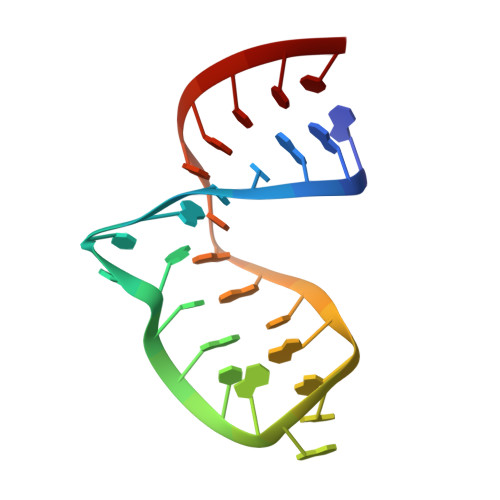NMR Localization of Divalent Cations at the Active Site of the Neurospora VS Ribozyme Provides Insights into RNA-Metal-Ion Interactions.
Bonneau, E., Legault, P.(2014) Biochemistry 53: 579-590
- PubMed: 24364590
- DOI: https://doi.org/10.1021/bi401484a
- Primary Citation of Related Structures:
2MIS - PubMed Abstract:
Metal cations represent key elements of RNA structure and function. In the Neurospora VS ribozyme, metal cations play diverse roles; they are important for substrate recognition, formation of the active site, and shifting the pKa's of two key nucleobases that contribute to the general acid-base mechanism. Recently, we determined the NMR structure of the A730 loop of the VS ribozyme active site (SLVI) that contributes the general acid (A756) in the enzymatic mechanism of the cleavage reaction. Our studies showed that magnesium (Mg(2+)) ions are essential to stabilize the formation of the S-turn motif within the A730 loop that exposes the A756 nucleobase for catalysis. In this article, we extend these NMR investigations by precisely mapping the Mg(2+)-ion binding sites using manganese-induced paramagnetic relaxation enhancement and cadmium-induced chemical-shift perturbation of phosphorothioate RNAs. These experiments identify five Mg(2+)-ion binding sites within SLVI. Four Mg(2+) ions in SLVI are associated with known RNA structural motifs, including the G-U wobble pair and the GNRA tetraloop, and our studies reveal novel insights about Mg(2+) ion binding to these RNA motifs. Interestingly, one Mg(2+) ion is specifically associated with the S-turn motif, confirming its structural role in the folding of the A730 loop. This Mg(2+) ion is likely important for formation of the active site and may play an indirect role in catalysis.
Organizational Affiliation:
Département de Biochimie et Médecine Moléculaire, Université de Montréal , C.P. 6128, Succursale Centre-Ville, Montréal, Québec H3C 3J7, Canada.















